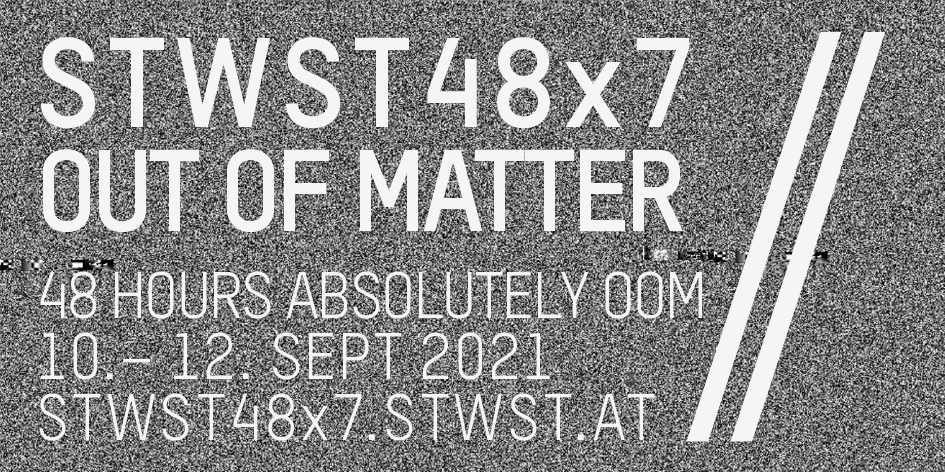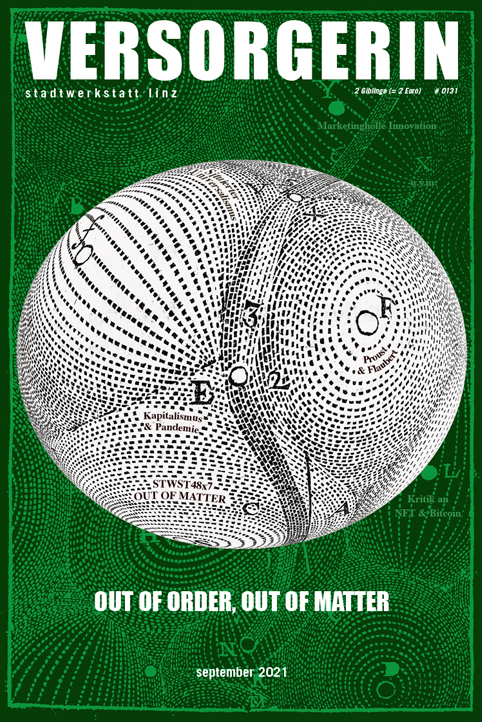This text offers a selection of research in the fields of Augmentation and Ecological Aesthetics and the projects that were developed using the TeleAgriCulture platform, with Stadtwerkstatt over the last three years. It argues that through Augmenting Ecological Aesthetics in Art, we can better understand our complex and multi-scalar relationships with living environments and therefore plan our Post-Anthropocenic futures better.
In Bleak Joys: Aesthetics of Ecology and Impossibility (2019), Fuller and Goriunova argue that critical discourse in ecology, particularly in relation to agriculture, industry and contemporary society, is problematic due to the topic being:
»An expansive one that is both hungrily sensual and abstract… about bad things, it discusses conditions such as anguish and devastation which relate to the ecological but are also constitutive of politics, the ethical and the formation of subjectivities and beings. These combine in the present day at multiple scales and in many ways, but they are also too often avoided, considered finite or absolute, rendered indifferent yet totalising, because we do not have the language to speak about them.«
Through Augmentation Aesthetics and embodied bio-digital interfacing, Art is able to build a languaging for Ecological Aesthetics that is both accessible and engaging, positioning several (difficult) topics within everyday social activities and scenarios. This is an aesthetics of augmentation that goes well beyond recent iterations of the term. This is not Pokemon Go, but rather a mixed reality discourse, embedded in a wider understanding of augmentation that goes beyond Computer Vision, diving into the liminalities of representation, interfaces and everyday cultures. This embedding in the everyday is essential, as the immediacy of climate action required demands it. Art can no longer look down from an ivory tower (or Inside the White Cube) in terms of sitting comfortably in exposition and speculation.
Art often remediates and reorientates ‘nature’ with very dangerous repercussions, in favour of obfuscating information and reason, keeping things hidden in the unconscious. As Morton suggests in Ecology Without Nature (2009): »Nobody likes it when you mention the unconscious, and nowadays, hardly anybody likes it when you mention the environment. You risk sounding boring or judgmental or hysterical, or a mixture of all these. But there is a deeper reason. Nobody likes it when you mention the unconscious, not because you are pointing out something obscene that should remain hidden, that is at least partly enjoyable. Nobody likes it because when you mention it, it becomes conscious. In the same way, when you mention the environment, you bring it into the foreground. In other words, it stops being the environment. It stops being That Thing Over There that surrounds and sustains us. When you think about where your waste goes, your world starts to shrink. This is the basic message of criticism that speaks up for environmental justice. (…) Strange as it may sound, the idea of nature is getting in the way of proper ecological forms of culture, philosophy, politics, and art (…) considering art above all else, for it is in art that the fantasies we have about nature take shape and dissolve.«
Art is both the original romancer and the obfuscator of the actual relationship humans have with our living environments and food certainly fits this scenario. Art developed a discourse that is inherent in Western Philosophy, of humans being privileged above all else, separating us from nature and the »otherness and sublime« of it. As Mishan wrote in her NY Times article Food Matters (2018) for centuries food has been both medium and topic and in recent times through social media, »food is appreciated as an almost exclusively visual medium, enshrined in hyper-processed, highly mannered photos without true corollaries in the physical world. It exists in a kind of suspended state of imagined deliciousness, never to be actually tasted by most viewers: a totem of eternally unconsummated desire. This is a perspective of extraordinary privilege, to be so secure in our food supply that we see food not as a requirement for biological survival but as entertainment«.
Of course, not all Art does this(!) and many artists meaningfully engage with ecology and the everyday, and recently food has emerged as an integral topic within this discourse. Perhaps evolving as a response to this somewhat apathetic frivolity in popular culture, a transdisciplinary movement has emerged that interfaces food production and consumption, with Art, Technology and Science. Interfacing Art with an essential part of life in nutrition, uses our innate human need for nourishment as a tactic to discuss how an ecological view transitions from knowledge in eating, cooking and growing, to the conditions in which something can nourish: where climatology, geology, chemical cycles, phase exchanges, soil and water science and more, converge as its biological basis. Our diets are intimately connected with our collective environment and food contains the imprint of the air we breathe, water we drink and earth we inhabit. Food is an index of biospherical health and its everyday production is a form of domestic science that is attuned with lived circumstances. Between the kitchen and the farm is ultimately an environmental science that we are all accustomed to, so by interfacing ecological discourses within this context, Art is able to articulate deeper, more confronting topics. But of course, an interface is useless without participation and the TeleAgriCulture platform was developed to facilitate deep engagement with and empathic responses to these topics.
TeleAgriCulture is a community platform, providing a crowd/cloud data exchange network for information, stories, Art and innovation. Modular sensing kits are offered and are adaptable to most geographic locations and ecological conditions, providing real time sensory data that can be used to monitor and optimise conditions or for artistic production and scientific inquiry. This creates a range of scenarios that while discrete in their operations, function as a networked community of communication and projects with a focus on resource driven circular economies of localised production and distribution. This is a paradigm (reverse) shift in food culture that is both easily accessible and usable for all low levels of digital literacy, but also advanced enough to engage field experts, through its integration of evolving technologies such as Machine Learning, Bio-engineering, Post-Anthropocenic Design (sustainability/zero carbon etc.) and DIY//DIWO culture, while acknowledging traditional and indigenous approaches.
For the previous three years, TeleAgriCulture has participated in the STWST48 Festival, with projects including Rhizomatic_Bias (STWST48x5, V2_ and Ars Electronica 2019), Maiz Matze: Speaking from the Grid Together (STWST 48x6 2020) and this year Riverbank Buffet for 48x7. In Rhizomatic_Bias, three aquaponic biospheres were set up at V2 (Rotterdam), Stadtwerkstatt and POSTCITY (Linz). The TeleAgriCulture kit networked sensory data, a chatbot and lights to communicate with each other, using traditional soil proverbs that are linked to class, wealth, luck, labor, productivity and land with emojis as a languaging system. In this bio-digital feedback loop the biospheres formed social relationships, based on how similar and statistically normal they were. Those with the most in common would attack the weaker ones, in effect cyberbullying them. This artistic provocation pointed at the much larger problems we face when our emotional biases and social constructions affect the way artificially intelligent systems evolve and impact agriculture. In 2020 Mais Matze created a labyrinth of communication for humans and corn to interact with big AgriData, through speech recognition, environmental sensing, an eco-data driven chatbot and sound and visual methods, to create greater empathy for food crops by augmenting and creating a voice and therefore agency for a corn crop, creating an evolving, interactive conversation cycle.
This year, Riverbank Buffet presents a multifaceted week-long lab based along the Donaulände, that culminates in a performative culinary event and workshop, interfacing food with microbial discourses, augmented to a human scale, through the processes of fermentation and Art. Working in collaboration with Roland van Dierendonck, this project is supported by the MAX Hyper Global/Hyper Local program and co-funded by the European Union. Much like a buffet, this project brings together several different approaches to food production into a single ecological palette for all to enjoy, using food that is grown exclusively along the Danube, using both traditional and modern methods that address issues of pollution, ecosystem recovery and health, through artistic analysis and experimentation with microbes. The project presents an approach to public engagement in local urban ecologies, incorporating the idea of tiny tastings of food, science and ecological farming that all relate to this central idea of riverbank-based food, presented as a performative picnic that continues as a workshop the following day. This project builds upon previous collaborations between Roland and I that focus on the processes of interfacing Science with Art and society through bio-digital methods and will be followed by the Feel Your Fermented Biome project which takes place on residency at The Coalesce Center for Biological Art in 2021.
Augmenting Ecological Aesthetics
More information about these and other previous/future projects can be found at teleagriculture.org or through contacting us directly.
The Riverbank Buffet takes place at STWST48x7 from 10.9-12.9.
Julian Stadon is an Australian artist/designer/curator/researcher/educator, lecturing for the Interface Cultures and Media Design Education Programmes at Kunstuniversität Linz and is also the Director TeleAgriCulture ad MARart.org. Studying Marine Biology, Fine Arts and Electronic Art, His PhD research focuses on how through Augmentation Aesthetics, Art can better our understandings of Bio-Digital Convergence, Identity and the socio-political and economic implications of Post-Anthropocenic Ecologies.
Previously he was Programme Leader for Digital Media at University of Hertfordshire/Tianjin Academy of Fine Art, Subject Leader in Innovative Media Production at London College of Fashion, Senior Lecturer for Interface/Interaction Design at FH-Salzburg
and has lectured in Perth at Murdoch, Curtin and Edith Cowan Universities. He also founded several hacker spaces including Dorkbot Perth, Digital Ping Pong London and Tinker_Nap_Lab Salzburg.
http://julianstadon.net


